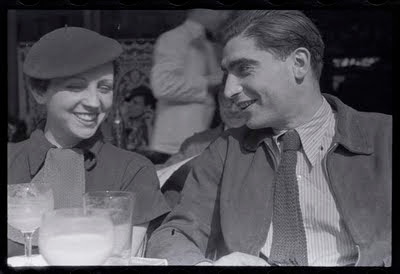Gerda Taro

Fred Stein, [Gerda Taro and Robert Capa on the terrace of Café du Dôme
in Montparnasse, Paris], early 1936. © Estate of Fred Stein.
International Center of Photography
Gerda Taro (real name Gerta Pohorylle; 1 August 1910, Stuttgart - 26 July 1937, near Brunete, Spain) was a Jewish German war photographer, and the companion and professional partner of photographer Robert Capa. Taro is regarded often as the first female photojournalist to cover the front lines of a war and to die while doing so.

Early life
Gerta Pohorylle was born in 1910, in Stuttgart, into a middle-class Jewish Polish family. Pohorylle attended a Swiss boarding school.[1][2]
In 1929 the family moved to Leipzig, just prior to the beginning of Nazi Germany. Taro opposed the Nazi Party, joining leftist groups. In 1933, she was arrested and detained for distributing anti-Nazi propaganda. Eventually, the entire Pohorylle household was forced to leave Nazi Germany toward different destinations. Taro would not see her family again.[2][3]
France
Escaping Hitler's Germany anti Semitism, Pohorylle moved to Paris in 1934. In 1935, she met the photojournalist Endre Friedmann, a Jewish individual of Hungary, becoming his personal assistant and learning photography. They fell in love. Taro began to work for Alliance Photo as a picture editor.[1][2][3][4]
In 1936, Taro received her first photojournalist credential. Then, both she and Friedmann devised a plan. Both took news photographs, but these were sold as the production of the nonexistent American photographer Robert Capa (after Frank Capra), which was a convenient name overcoming the increasing political intolerance which predominated in Europe and belonging in the well rewarding American market. The secretiveness of the maneuver did not last long, but Friedman kept the more commercial name "Capa" for his own name, and Pohorylle adopted the professional name of "Gerda Taro" after the Japanese artist Tarō Okamoto and Swedish actress Greta Garbo.[1][2][3][5] The two worked together to cover the events surrounding the arrival to power of the Popular Front in the 1930s in France.
Spanish Civil War
When the Spanish Civil War broke out (1936), Gerda Taro travelled to Barcelona, Spain, to cover the events with Capa. Taro acquired the nickname of la pequeña rubia ("the little blonde"). They covered the war together at northeastern Aragon and at the southern Córdoba. Always together under the common, bogus signature of Robert Capa, they were successful through many important publications (the Swiss Züricher Illustrierte, the French Vu). Their early war photos are distinguishable since Taro used a Rollei camera which rendered squared photographs while Capa produced rectangular Leica pictures. However, for some time in 1937 they produced similar 135 film pictures together under the label of Capa&Taro.[1][2][3][6]
Subsequently, Taro attained some independence. She refused Capa's marriage proposal. Also, she became publicly related to the circle of anti fascist European intellectuals (Ernest Hemingway, George Orwell) who crusaded particularly for the Spanish Republic. The Ce Soir, a leftist newspaper of France, signed her for publishing Taro's works only. Then, she began to commercialize her production under the Photo Taro label. Regards, Life, Illustrated London News and Volks-Illustrierte were amongst those publications.[1][2]
Reporting the Valencia bombing alone, Gerda Taro attained the photographs which are her most celebrated. Also, in July 1937, Taro's photographs were in demand by the international press when, alone, she was covering the Brunete region near Madrid for Ce Soir. Although the Nationalist propaganda claimed that the region was under its control, the Republican forces had in fact forced that faction out. Taro's camera was the only testimony of the actual situation.[1][2][3]
Death
During her coverage of the Republican army retreat at the Battle of Brunete, Taro hopped onto the footboard of a car that was carrying wounded soldiers when a Republican tank collided into its side. Taro suffered critical wounds and died the next day, July 26, 1937.[1]
The circumstances of Taro's death have been questioned by British journalist Robin Stummer, writing in the New Statesman magazine.[7] Stummer cited Willy Brandt, later Chancellor of West Germany, and a friend of Taro's during the Spanish Civil War, that she had been the victim of the Stalinist purge of Communists and Socialists in Spain not aligned to Moscow. However, Stummer provided no other evidence for this claim.
In an interview with the Spanish daily El País, a nephew of a Republican soldier at the Battle of Brunete explained that she had died in an accident. According to the eye-witness account, she had been run over by a reversing tank and she died from her wounds in El Goloso English hospital a few hours later.[8]
Due to her political commitment, Taro had become an anti-fascist figure. On August 1, on what would have been her 27th birthday, the French Communist Party gave her a grand funeral in Paris, buried her at Père Lachaise Cemetery, and commissioned Alberto Giacometti to create a monument for her grave.[9]
On 26 September 2007, the International Center of Photography opened the first major U.S. exhibition of Taro's photographs.
http://en.wikipedia.org/wiki/Gerda_Taro

Comments